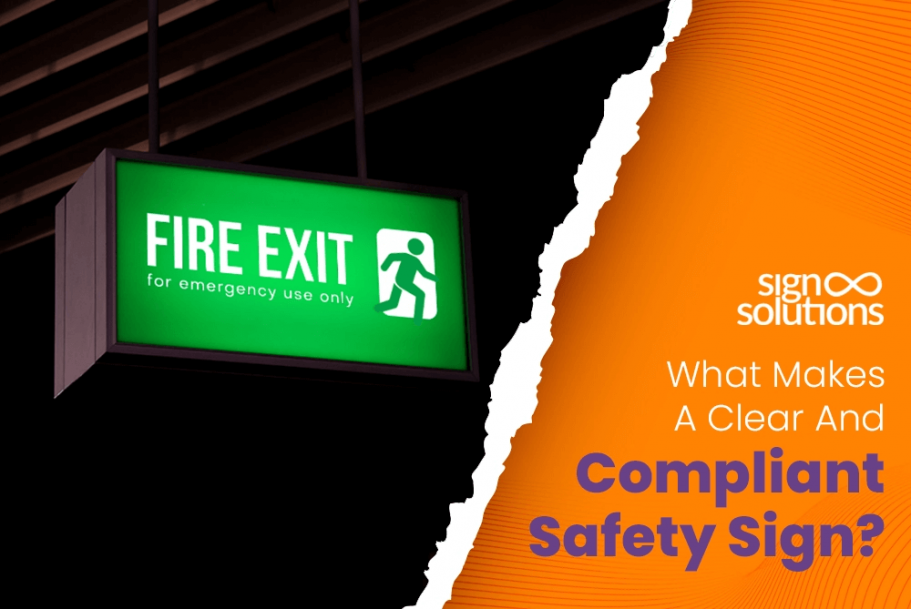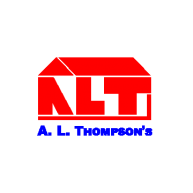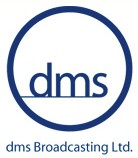Sign Solutions has been our "Go-To" source for all of our Corporate sign, banner and vehicle branding needs for years. Their team is always extremely responsive and their product quality is exceptional for the price. We highly recommend the services of the Sign Solutions!
What Makes A Clear And Compliant Safety Sign?
Introduction
Visualize:
Suppose you are walking down a heavily bustling construction site. Looking around, you see heavy machinery humming their way, performing their daily tasks. You also witness laborers running around wearing high-visibility gear. You breathe risk all around the premises.
But what you don’t see is a single warning sign pointing to the falling debris. A more surprising fact is that there is neither any indication of emergency exits nor reminders to wear protective gear for everyone entering or entering this construction site.
What does this scenario indicate?
With no words spoken ever, the bustling silence of this civil work indicates missing safety signs that ‘Scream Danger.’
Understanding Safety Signs:
A general opinion about safety signs is that they are nothing more than just colorful boards with bold symbols, which is a total myth.
In reality, these safety signs are our true and silent guardians, protecting lives in workplaces, public spaces, and construction zones. From preventing slips in a multi-storeyed mall, a multiplex theatre, or a decent-sized grocery store, these signs play a vital role in maintaining awareness, preventing accidents, and guiding toward safe passage during emergency evacuations.
Are all safety signs equally effective?
No, not all safety signs are created equal. They can be truly effective and impactful only if they are both clear and compliant.
Most organizations seriously risk their employees and visitors by installing unclear or non-compliant signage within their premises. Not complying with the strict guidelines laid down by the local government authorities can endanger the safety of organizations, further leading to regulatory penalties, lawsuits, accidents, and injuries. No company would wish its infrastructure to get victimized because of poor safety signs. Hence, it is essential to have well-placed, easy-to-understand signs installed at the right locations to save everything from catastrophic damage. Because we belong to an educated and civilized society, it is our moral responsibility to have our signage meet both visual and legal standards.
In this blog, we will discuss what makes a safety sign both clear and compliant. We will explore essential design elements like visibility, symbols, and language; the standards set by governing bodies like OSHA and ISO; and how to assess whether your signage truly serves its purpose.
Whether you're prepping a factory floor or updating signage in a community center, understanding these key factors could help save lives—and keep you on the right side of the law.
The Purpose of Safety Signs
Anything that exists in this world has a purpose to fulfill. Take up a factory, a construction site, a manufacturing plant, a warehouse, a public facility, or a residential colony. Safety sign importance at each of these locations cannot be overstated. Safety signs are visual tools that always prove critical in times of emergency and help people stay safe. Workplace safety signs can come in handy only if they provide clear and immediate communication to save people from accidents, reduce confusion, and support compliance, as mentioned in the safety regulation guidelines.
Carelessness on the part of the users is a major cause of accidents that no one can deny. Along with carelessness, lack of awareness is equally responsible for hazardous conditions erupting in and around the commercial premises. It is not that difficult to identify a risk-borne location, but properly installing hazard warning signs can make life easier.
When hazard warning signs are placed at recommended positions, they not only alert individuals about potential dangers but also caution them about possible risks. Slippery floors, high-voltage equipment, and flammable materials are a few examples of high-risk environments. When safety signs perform their duties well, untoward incidents can be prevented. Our lives have become so mechanical that we forget to notice or remember important things. Hence, properly designed and accurately positioned safety signs constantly remind us of their presence, purpose, and safety. They keep prompting people to think twice, be cautious, and act responsibly.
Do you consider that the role of workplace safety signs is just limited to avoiding injuries? Besides delivering a safe environment, these safety signs are there to meet legal and regulatory standards. Regarding safety concerns, organizations like OSHA and the HSE have made it mandatory to use proper signage that warns about possible risks and directs people to safe passages. Human safety cannot be trivialized. Hence, organizations, big or small, must comply with recommended safety standards to save on hefty fines, legal issues, and reputational damage.
When any company adheres to having clear and compliant safety signs placed within their premises, it fosters a culture of responsibility and awareness. Safety signs placed in manufacturing units, construction sites, and medical facilities direct employees to follow safe behavior practices, like wearing PPE kits, helmets, and gloves. These signs help people locate and safely reach fire exits and evacuation routes by delivering quick and understandable messages. Thanks to hazard warning signs. They make our work environment more organized and significantly safer.
The importance of safety signs has augmented as they have been instrumental in saving lives, protecting property, and promoting a proactive approach to risk management and mitigation. Proper sign performance creates an opportunity for a better and safer society.
Essential Features of a Clear Safety Sign
A well-designed and properly placed safety sign is there to make all the difference when the situation is crucial. It all begins with alerting the factory workers during hazardous conditions to direct the public toward safe passage. Only a safety sign with adequate clarity can perform effectively during an emergency. Hence, a safety sign with a clear signage design might look nice to have luxury but will prove essential in need of the hour.
There is nothing more important than having clarity in design, as it makes any sign effective and powerful. Besides, you need simple icons for instant communication, bold typography to make the sign visible even from a distance, and easy-to-understand language that helps the user understand your message easily. No guesswork works when safety is your paramount need. You will get to see the beauty of readable safety signs when their direct words and universally recognized symbols make them easy to understand, even for a non-native speaker.
Readability is important, but capturing a reader’s attention and holding it requires you to use high-visibility signs. These high-visibility signs use smart color coding and strong contrast for optimum reading experience. A simple example can be to use (think) red for danger, yellow for caution, and green for safety.
All these colors haven’t been chosen randomly. In reality, they’re part of an internationally recognized system that triggers immediate recognition and reaction. Having dark backgrounds or stark white text combined with these colors dramatically improves visibility, even in low-light conditions or high-clutter environments. Isn’t this amazing?
The reason why we insist on using a clear signage design is that such signs work in any setting. They will perform equally indoors or outdoors, on a noisy factory floor or a quiet office corridor.
Besides enhancing awareness, these clear designs ensure that everyone knows exactly,
- What to do,
- Where to go,
- What to avoid.
Organizations should combine readable safety signs with high-visibility signs to ensure their messages are clearly understood.
Compliance with Safety Regulations
When it comes to protecting lives and maintaining safe environments, safety signs are not just helpful—they are essential. Around the world, safety sign regulations establish strict standards regarding the appearance of signs, their placement, and the messages conveyed. Understanding and adhering to these rules is crucial not only for ensuring people's safety but also for complying with legal requirements.
In the United States, OSHA-compliant signs are legally required in most workplaces. The Occupational Safety and Health Administration (OSHA) mandates the use of specific colors, symbols, and wording to communicate risks and safety instructions clearly. These signs adhere to guidelines established in collaboration with the American National Standards Institute (ANSI), which provides detailed specifications on sign formats, text size, symbol usage, and placement.
Internationally, the ISO 7010 standard is widely recognized. It establishes consistent design elements for safety signs used across countries, ensuring that a warning about electrical hazards or fire exits conveys the same message whether you’re in London, Tokyo, or Toronto. These global safety sign regulations help create a universal language of safety that transcends borders and cultures.
Failing to comply with workplace signage laws can have serious consequences. Organizations that neglect proper signage may face hefty fines, legal liabilities, or even criminal charges if their negligence leads to injury or death. Beyond legal issues, non-compliance can damage a company’s reputation, lower employee morale, and increase the risk of costly accidents.
By investing in OSHA-compliant signs and adhering to global standards, businesses show their commitment to safety and responsibility. It's not merely about evading penalties; it's about creating a workplace where everyone feels informed, protected, and empowered to act safely. After all, compliance isn’t just a checkbox; it’s a fundamental aspect of effective risk management.
Choosing the Right Symbols and Pictograms
In an emergency, the risk becomes high, for which every second counts. To take charge of people’s safety, it is important to have clear and instant communication. Such communication will direct people to the safe exit. When people don’t have much time to read the text, safety pictograms prove to be the most effective signage. The pictogram signs are simple yet highly powerful. Where pure texts might fail, images within the pictograms deliver urgent messages clearly without any lengthy explanations. They also ensure that everyone, regardless of language or literacy level, understands what action is to be taken or what danger should be avoided.
Where lengthy texts are not preferred, universal safety symbols show their true strength. They easily break down communication barriers and make the message within the sign simple to understand and follow. In workplaces where employees belong to diverse cultural backgrounds and speak different languages, depending on text alone can lead to confusion, chaos, or missed warnings. Make use of universal safety symbols by switching to a well-designed pictogram that speaks a global language and is accepted worldwide.
A few examples of universal safety symbols can be: A flame icon instantly signals a fire hazard. A skull and crossbones indicate toxic materials. A lightning bolt within a triangle or rectangle with a yellow or orange background shows high-voltage power. These symbols are instantly recognizable and leave little room for confusion.
Using standardized workplace safety signs with accepted symbols is often required by law. It might not seem smart, but it helps keep everyone safe. ISO, ANSI, and OSHA created libraries of approved safety pictograms. This helps keep safety signs clear and consistent across different industries and areas. Researchers have tested and proven these symbols. They are well-known, which allows organizations to share risks clearly and fairly.
Using universal safety symbols in your signs makes them clearer. This also shows that you care about safety and respect everyone on the team. Choosing the right pictograms makes your workplace hazard signs smarter and faster. This is true whether you manage a local crew or a global workforce. When it comes to safety, we should never lose our understanding of translation.
Material and Durability Considerations
Every safety sign must prove its effectiveness. You will get to see its efficacy only if it is made from the right material, which is durable and can stand the test of time. Safety signs, when placed in outdoor environments, manufacturing plants, and high-traffic zones, get constantly exposed to harsh weather conditions like rain, sunlight, dust, chemicals, and physical wear and tear. Hence, it is essential to use the right materials to make durable safety signs. Insisting on quality is vital, but safety should be paramount.
If you have the slightest doubt, always opt for weatherproof signage. Such signage ensures great visibility and compliance over time. What sense does it make to continue having a faded, cracked, or corroded sign installed at a location that cannot deliver the intended message to its audience? We generally get to see the harsh impact of weather on signs that are installed in outdoor and industrial settings. These signs remain exposed to UV rays, heavy sunlight, moisture, dust, and extreme temperatures. The best strategy to survive in such conditions is to choose the right material that resists fading, peeling, and rusting. This material also ensures that your safety message remains clear and compliant for years to come.
Different industrial signage materials offer varying levels of durability and functionality:
- Aluminum is a powerful metal that doesn’t rust. Hence, it has gained popularity as the best choice for weatherproof signage. The strength that aluminum brings along makes it an ideal choice for outdoor use. Moreover, aluminum performs great in both hot and cold climates.
- PVC (Polyvinyl Chloride) is a material that is lightweight, cost-effective, and suitable for indoor or sheltered environments. We do understand that PVC is not as rugged and robust as aluminum, but it has the potential to resist moisture and most chemicals.
- Photoluminescent signs are unique. After exposure to light, they begin glowing in the dark. Hence, photoluminescent signs make a great choice for low-light conditions or emergencies like power outage conditions. These are often used in evacuation routes or stairwells to ensure visibility, even when lighting fails.
The right industrial signage materials for you depend on your environment and application. If your signs will be in direct sunlight all year, aluminum is a good choice. For cleanrooms or hallways, consider PVC. If you need signs that remain visible during blackouts, photoluminescence is the best option.
Durable safety signs ensure your message remains visible, clear, and effective—regardless of the conditions. Choosing the right materials from the start can help avoid accidents. It can also cut down on maintenance costs. Plus, it keeps your facility safe and compliant for years.
Related Blog: Crafting Effective Safety Signs: A Comprehensive Guide for Every Business
Proper Placement for Maximum Effectiveness
A well-designed safety sign makes sense only if it is placed so that everyone can see it and read the message on it. Hence, safety sign placement is equally important as the design and the content of the sign. From factories and warehouses to hospitals and public buildings, the height, location, and angle of the sign can drastically influence the impact that sign creates. The accurate position can help the message be communicated effectively and help prevent accidents from happening.
With the proper sign positioning, the critical message becomes visible to all. The primary purpose of that sign is to save someone from being exposed to a risk by using a safety sign. As a regular practice, safety signs must be placed at eye level, typically between 1.5 to 2 meters from the ground. This height ensures that the sign is easily seen without needing to look up or down. They should face oncoming traffic, whether that’s foot traffic in a hallway or machinery operators on a busy floor. The slightest information present on the sign should be clearly visible from a distance, too.
Workplaces are risk-prone areas. Hence, workplace safety signs should be placed strategically in such high-risk areas. For example:
- Warning signs for electrical hazards are location-specific. They should be posted directly on or near the electrical panel, as well as on approach paths.
- “PPE Required” signs should be placed at entry points in those specific areas where using protective equipment or guards is mandatory. People should know the requirements of such areas even before entering them.
- Emergency exits are never used on normal days yet hold the highest significance. Hence, the view to emergency exit signs must be unobstructed and visible from multiple vantage points. This is especially true for premises with complex layouts or low-light conditions.
Workplace safety signs are a must for prime locations like high-traffic zones, intersections, and transitional areas (like entrances to hazardous zones). Proper placement of signs helps prevent visual clutter. Too many signs crammed together are never in the interest of the viewers as they dilute the message. To further help the viewers, keep your message focused. The space must be set appropriately, and the signage should be well-maintained for optimal impact.
The Role of Digital and Smart Safety Signage
In today's fast-paced environment, static signs are sometimes not fast enough. Digital safety signage revolutionizes hazard communication in real time. No matter what the situation, whether it's a chemical spill, a machine malfunction, or an emergency evacuation, these signs can be updated instantly.
LED warning signs are unique in nature and are especially valuable in high-noise or low-light environments. They grab attention with flashing lights and dynamic messages. Unlike traditional signage, they adapt on the fly, offering timely alerts that can save lives.
Adding smart safety signs to IoT systems will make the future even smarter. These connected signs can receive data from sensors and automation systems regarding temperature spikes, gas leaks, or motion detection and immediately display warnings or directions. Aside from facilitating emergency response, this reduces human error and improves workplace awareness as well.
With digital safety signage, safety becomes dynamic, data-driven, and powerfully effective. It’s not just about showing a message—it’s about delivering the right message at exactly the right time.
Safety Signs by SignSolutions
When it comes to protecting people and staying compliant, SignSolutions delivers the best safety signs you can count on. We specialize in high-quality, regulation-compliant signage designed to meet OSHA, ISO, and local standards—ensuring your workplace is always safe, clear, and up to code.
Whether you need standard warning signs or fully custom workplace signage tailored to your specific environment, SignSolutions has you covered. From design and manufacturing to professional installation, we offer a complete end-to-end solution that takes the stress out of safety.
Based right here in the islands, we’re proud to be your go-to provider for safety signs in Cayman, helping businesses create safer environments with signage that stands out and stands the test of time.
Conclusion
A clear and compliant safety sign is more than just a label—it’s a life-saving communication tool. From its readable design and universal symbols to durable materials, proper placement, and regulatory compliance, every detail plays a critical role in keeping people safe and informed.
Now is the time to take a closer look at your signage. Are your signs visible, current, and legally compliant? If not, it's time to take action. Regular audits of your safety signage can help prevent accidents, reduce liability, and create a safer environment for everyone.
Need assistance? Let SignSolutions be your reliable partner. We provide expert guidance, tailored signage solutions, and comprehensive installation services to ensure your workplace remains clear, compliant, and secure. Reach out to us today to enhance your safety signage with confidence.
Recent Blog

Stand Out Day or Night: The Power of Backlit Signage for Your Business
When seeing is believing, visibility goes beyond the basic conventions in spreading the awareness of your brand, far and wide. When a customer walks d...
Read More
Easy Ways to Create Stylish Interiors with Custom Signage
Imagine that you visit a store as a customer that houses various products. You enter the store and observe that the store only has products on display...
Read More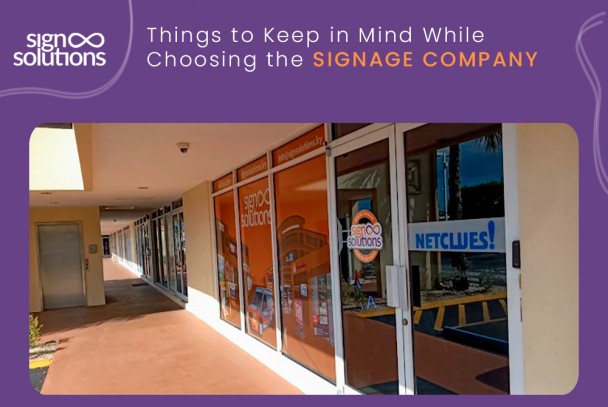
Things to Keep in Mind While Choosing the Signage Company
Would you prefer visiting a doctor to get your ailment diagnosed or simply consume a medicine suggested by a friend who doesn’t belong to the medica...
Read More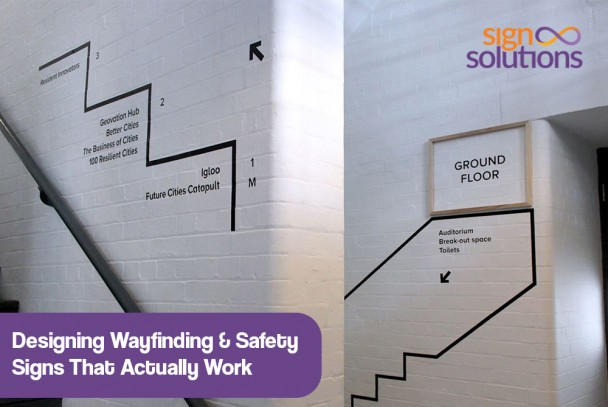
Designing Wayfinding & Safety Signs That Actually Work (A Complete Guide)
Ever visited a place for the first time and saw wayfinding signs at various locations, corners, and departments to help you reach the next destination...
Read More
Custom Teardrop Banners in Cayman: Make Your Brand Unmissable
The basic question today is, why do we need to rely on signs or banners for our business? The simplest answer is to generate brand visibility for our ...
Read More
